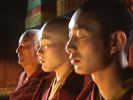Eye For Film >> Movies >> Samsara (2011) Film Review
Samsara falls into that curious film genre that might be called 'non narrative, lyrical-musical documentary' - a category which contains well-regarded films such as Koyaanisqatsi: Life Out Of balance, Powaqqatsi: Life In Transformation, and Naqoyqatsi: Life As War, and 1992's Baraka. It is Baraka director Ron Fricke that is the directing and cinematography mastermind behind this year's Samsara. Those who have seen Baraka and Fricke's other work (he was, amongst other things, cinematographer on Koyaanisqatsi) will know what to expect: a 'pulse-of-humanity/circle-of-life' voyage that looks to illuminate the broader parallels between different cultures, captured by incredibly high resolution cameras rendered with top of the line post production, taking the viewer across the planet's landscapes and amongst its many peoples. All set to an evocative, ethnically diverse collaborative score.
Like Baraka, Samsara is being billed as a “nonverbal, guided meditation that will transform viewers in countries around the world, as they are swept along a journey of the soul.” The press material for this film promised pristinely photographed and post-produced 70mm footage shot in over two dozen countries, backed by a dynamic score. It certainly delivers on this front. Seen at 4K resolution on a big screen, the vistas that are laid out before the viewer – a rolling sequence of Tibetan monasteries, giant Chinese industrial plants, Saharan deserts at night, all bathe the eye in beauty. Nothing is rushed. The cameras pan and tilt slowly in sync with the score, allowing you plenty of time to drink it all in. Time lapse and slow motion sequences convey the idea that humanity is always moving, and moving in patterns, so much larger than any individual at ground level could see. The score itself is an appropriate melting pot for such an international sweep, featuring work from Dead Can Dance singer/composer Lisa Gerrard.

Samsara has no plot, no storyline, no actors, no dialogue nor any voice-over. It's kaleidoscopic, a compilation and a comparison of natural and technological phenomena, patterns, and rituals. A painstakingly detailed Buddhist sand mural frames the opening and close of the film - a motif of impermanence and circularity (as the monks disperse the sand image once it is complete, presumably to then build another one). No one country or phenomenon is prioritised. The camera jumps from the slums of China one minute, to a slaughterhouse the next. Particular editing choices invite the viewer to spot themes, motifs, and parallels- in one sequence we see shots of female Japanese animatronic androids emoting, intercut with static shots of heavily made-up, pouting Japanese female models. Which seems more human now?
Given that such high-end camera and post production technology is usually used to film kinetic/frenetic CGI-heavy action films, the change of pace will no doubt be welcomed by some. The success of recent documentary productions such as the BBC's Frozen Planet proves audiences are still hungry for thought-provoking HD imagery of the more extreme parts of the globe.
Given its broad sweep, Samsara might feel a touch naïve in its attempt to show via imagery and score that we are 'all one' in the great patterns of birth, struggle, work, love, death. It also features so many canvasses of epic beauty, captured by a lazily panning camera whose movements you soon learn to predict, that it actually begins to become a little wearying. Luckily, Fricke changes the game up part way through by taking his cameras away from the deserts and rainforests and into more morally troubling terrain - into the heart of the mechanised, automated landscapes that form the superstructures that prop up our western industrialised nations and their developing world competitors. There are some truly breathtaking and bizarre locales to be seen here, made all the more potent in that the images we see are CGI-free and are showing us an essential cog in the chain of what we eat, drink, and touch every day. A giant metal wheel like something out of Kubrick's 2001 carrying hundred of cows that are connected to milking automata, a giant Chinese factory city where hordes of identically dressed workers flow in time-lapse waves like worker bees from door to door, a slaughterhouse factory line where the camera tracks along with the mobile hanging cow corpse, time-lapsing us through its dismemberment and packaging. Perhaps something that would work better on DVD or in a gallery, where you can wander in and out,Samsara is a stunning visual spectacle to behold. Just be ready for a film that isn't afraid to wear its life-affirming heart on its sleeve.
Reviewed on: 30 Aug 2012


















